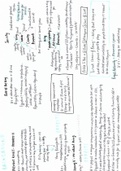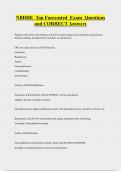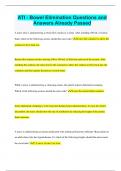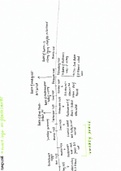Readings Week 36; What is Systems thinking? Monat
& Gannon
What is systems thinking?
- Systems thinking is a perspective, a language and a set of tools.
- It is opposite to linear thinking, it is:
o Holistic (integrative) instead of analytic (dissective).
- It recognizes that repeated events or patterns derive from systemic structures which, in turn
derive from mental models.
o Recognizing the fact that behaviours are derived from structures.
- It provides a focus on relationships instead of components and it appreciates self-
organization and emergent properties of systems.
Via the literature precisely:
1) a perspective that recognizes systems as collections of components that are all interrelated
and necessary, and whose inter-relationships are at least as important as the components
themselves;
2) a language centred on the Iceberg Model, unintended consequences, causal loops,
emergence, and system dynamics, and
3) a collection of tools comprising systemigrams, archetypes, causal loops with feedback and
delays, stock and flow diagrams, behaviour-over-time graphs, main chain infrastructures,
system dynamics/computer modelling, interpretive structural modelling, and systemic root
cause analysis.
What can systems thinking do and what does it consist of?
- Systems thinking has great power in solving complex problems that are not solvable using
conventional reductionist thinking. It can be used to explain dynamic non-linear behaviours.
- Dissective thinking, ignores relationships among system components, even though these
relationships dominate systems behaviour.
- Systems thinking takes a holistic view, involving both spatial and temporal elements.
o It requires we ask, what circumstances and attitudes led to this point?
o What actions and behaviours led to this point?
o What are likely attitudes, actions and patterns going forward?
o What are likely reactions of involved parties and the environment going forward?
Systems thinking requires a vision of the future and understanding of the
past.
- Systems thinking does not replace any traditional forms of thinking it complements them.
- Self-organization is a process in which a pattern at the global level of a system emerges
solely from numerous interactions among the lower level components of the system.
o This pattern is only self-organizing when no external information has led to its
development and thus used only ‘local information’.
- Emergence entails properties that emerge/ come forth out of a system which are properties
of the whole system instead of solely being properties of individual components.
- Systems thinking deals with:
o Organized complexity, instead of organized simplicity or unorganized complexity.
- System thinking requires us to recognize that in human-made systems repeated events and
patters are derived from systemic structures, which come from mental models. As explained
in the Iceberg model
- The Iceberg Model argues that events and patterns are caused by systemic structures and
mental models, which are often hidden.
, o Systemic structures are the organizational or social hierarchy; interrelationships;
rules and procedures; reactions incentives, fears; feedback loops and delays in the
system dynamics; and underlying forces that exist in an organization. Behaviours
derive from these structures, which are (in turn) established due to mental models or
paradigms.
o To understand behaviours, we must first identify and understand the systemic
structures and underlying mental models that cause them.
Important literary additions to systems thinking
- Weinbergs three great systems thinking questions:
o Why do I see what I see?
o Why do things stay the same?
o Why do things change?
- Gharajedaghi’s 5 system principles:
o Openness; Purposefulness; Multi-dimensionality; Emergent properties; Counter-
intuitiveness.
- Valerdi’s 7 system thinking competencies:
1. Ability to define the "universe' appropriately - the system operates in this universe
2. Ability to define the overall system appropriately - defining the right boundaries
3. Ability to see relationships - within the system and between the system and universe
4. Ability to see things holistically - within and across relationships
5. Ability to understand complexity - how relationships yield uncertain, dynamic, nonlinear
states and situations
6. Ability to communicate across disciplines - to bring multiple perspectives to bear
7. Ability to take advantage of a broad range of concepts, principles, models, methods and tools
- because any one view is inevitably wrong.
What are systems archetypes?
- Systems Archetypes. In systems thinking, archetypes are problem-causing structures that are
repeated in many situations, environments, and organizations. Being facile at identifying
them is the first step in changing the destructive structure.
- There are 10 common archetypes:
o Accidental Adversaries,
o Fixes that Fail (policy resistance),
o Limits to Growth, Shifting the Burden (addiction),
o The Tragedy of the Commons,
o Drift to Low Performance (eroding goals),
o Escalation,
o The Rich get Richer,
o Rule Beating,
o Seeking the Wrong Goal.
, - These 10 archetypes are very common in business situations, and the literature presents
many suggestions for dealing with them. The key is to first identify them.
Readings Week 37; Samenvatting
Alwood et al., (2013). Material efficiency: providing material services
with less material production.
What is material efficiency?
- The pursuit of the technical strategies, business models, consumer preferences and policy
instruments that would lead to a substantial reduction in the production of high-volume
energy-intensive materials required to deliver human well-being.
- Focussing on material efficiency is done as it can help with:
o Reducing energy demands
o Reducing emissions and other impacts of industry
o Increasing national resource security
- Policy will be required to stimulate material efficiency as current economic structures are not
adept to it.
Introduction
- With the current growing population, the demand is also growing for material extraction and
processing.
- Many technological limits in process efficiency have already been found, and can’t be pushed
further. So there is a pressing need for a differing response to the growing population and
demands. Such as increased recycling, circularity, and material efficiency.
- Focussing on providing the same services, but with a reduction in the total production of
NEW material.
Motivations for material efficiency
- The core motivation for examining material efficiency is its potential as an emissions
abatement strategy:
o Material production is both energy intensive and already largely energy efficient.
Focussing on mitigating and lessening all negative externalities of production
regarding materials.
- Two other motivations to pursue material efficiency:
o Criticality:
The importance of material efficiency in discussions about rare and critical
metals. The rate at which these metals would became critical would slow
down drastically.
o Resource Convergence:
Vasara et. al. recognize that many resource stresses and responses to those
stresses are coupled to stresses and responses from other key resources.
o An Important aspect in material efficiency is life-cycle thinking, certain decisions
might in the short term lead to differing outcomes than wanted. But in general
material efficiency can open up a lot of opportunities.
, - Thus material efficiency is likely to become a priority strategy in the wider area of responding
to resource stresses other than energy and emissions.
- There are four major options focussing on energy and process efficiency:
o Increased recycling;
Potential constrained by volume of material available for recycling.
Furthermore stocks will need to stop growing before ‘circularity’ can
effectively achieved.
o Material substitution;
There have to be suitable substitutive materials for those in the current
market, with similar performance. These are hard to find sufficiently.
o Powering industry with low-carbon electricity;
Non-easy options, infrastructure is not yet in place and requires great scale,
furthermore its just one of three sectors aiming towards large-scale use of
low-carbon energy, thus making the challenge even greater. Additionally a
mention of risky, focussing on solely one ‘technological fix’.
o Carbon capture
Not applicable for all processes and expensive.
Technical options for implementing material efficiency
- Six broad strategies are mentioned:
o Light weight design;
1/3 of materials could be saved if processes focussed on light-weight design
instead of cost reduction.
o Reducing yield losses;
Can help save materials across the entire supply-chain.
o Diverting manufacturing scrap;
Could be re-used as new input in the manufacturing process
o Re-using components
Re-using functioning components of malfunctioning products.
o Longer-life products
Products designed for repair or simply built more sturdy, in order that they
can be used for longer.
o More intense use
New manners of value-creation out of products such as leasing, meaning
more people can use products solely when needed, and hopefully thus
reducing the total amount of those products, leading to less environmental
pressure.
- These strategies however might conflict with each other, three conflicts require further
investigation.
o The optimization of component mass through light-weight design may inhibit future
component re-use.
o Reducing yield losses cuts the availability of scrap for diversion or recycling.
o Maintaining an energy-using product in use over a longer life may delay the
opportunity to adopt technology improvements which lead to reduced energy
requirements in use.
Economics and material efficiency
& Gannon
What is systems thinking?
- Systems thinking is a perspective, a language and a set of tools.
- It is opposite to linear thinking, it is:
o Holistic (integrative) instead of analytic (dissective).
- It recognizes that repeated events or patterns derive from systemic structures which, in turn
derive from mental models.
o Recognizing the fact that behaviours are derived from structures.
- It provides a focus on relationships instead of components and it appreciates self-
organization and emergent properties of systems.
Via the literature precisely:
1) a perspective that recognizes systems as collections of components that are all interrelated
and necessary, and whose inter-relationships are at least as important as the components
themselves;
2) a language centred on the Iceberg Model, unintended consequences, causal loops,
emergence, and system dynamics, and
3) a collection of tools comprising systemigrams, archetypes, causal loops with feedback and
delays, stock and flow diagrams, behaviour-over-time graphs, main chain infrastructures,
system dynamics/computer modelling, interpretive structural modelling, and systemic root
cause analysis.
What can systems thinking do and what does it consist of?
- Systems thinking has great power in solving complex problems that are not solvable using
conventional reductionist thinking. It can be used to explain dynamic non-linear behaviours.
- Dissective thinking, ignores relationships among system components, even though these
relationships dominate systems behaviour.
- Systems thinking takes a holistic view, involving both spatial and temporal elements.
o It requires we ask, what circumstances and attitudes led to this point?
o What actions and behaviours led to this point?
o What are likely attitudes, actions and patterns going forward?
o What are likely reactions of involved parties and the environment going forward?
Systems thinking requires a vision of the future and understanding of the
past.
- Systems thinking does not replace any traditional forms of thinking it complements them.
- Self-organization is a process in which a pattern at the global level of a system emerges
solely from numerous interactions among the lower level components of the system.
o This pattern is only self-organizing when no external information has led to its
development and thus used only ‘local information’.
- Emergence entails properties that emerge/ come forth out of a system which are properties
of the whole system instead of solely being properties of individual components.
- Systems thinking deals with:
o Organized complexity, instead of organized simplicity or unorganized complexity.
- System thinking requires us to recognize that in human-made systems repeated events and
patters are derived from systemic structures, which come from mental models. As explained
in the Iceberg model
- The Iceberg Model argues that events and patterns are caused by systemic structures and
mental models, which are often hidden.
, o Systemic structures are the organizational or social hierarchy; interrelationships;
rules and procedures; reactions incentives, fears; feedback loops and delays in the
system dynamics; and underlying forces that exist in an organization. Behaviours
derive from these structures, which are (in turn) established due to mental models or
paradigms.
o To understand behaviours, we must first identify and understand the systemic
structures and underlying mental models that cause them.
Important literary additions to systems thinking
- Weinbergs three great systems thinking questions:
o Why do I see what I see?
o Why do things stay the same?
o Why do things change?
- Gharajedaghi’s 5 system principles:
o Openness; Purposefulness; Multi-dimensionality; Emergent properties; Counter-
intuitiveness.
- Valerdi’s 7 system thinking competencies:
1. Ability to define the "universe' appropriately - the system operates in this universe
2. Ability to define the overall system appropriately - defining the right boundaries
3. Ability to see relationships - within the system and between the system and universe
4. Ability to see things holistically - within and across relationships
5. Ability to understand complexity - how relationships yield uncertain, dynamic, nonlinear
states and situations
6. Ability to communicate across disciplines - to bring multiple perspectives to bear
7. Ability to take advantage of a broad range of concepts, principles, models, methods and tools
- because any one view is inevitably wrong.
What are systems archetypes?
- Systems Archetypes. In systems thinking, archetypes are problem-causing structures that are
repeated in many situations, environments, and organizations. Being facile at identifying
them is the first step in changing the destructive structure.
- There are 10 common archetypes:
o Accidental Adversaries,
o Fixes that Fail (policy resistance),
o Limits to Growth, Shifting the Burden (addiction),
o The Tragedy of the Commons,
o Drift to Low Performance (eroding goals),
o Escalation,
o The Rich get Richer,
o Rule Beating,
o Seeking the Wrong Goal.
, - These 10 archetypes are very common in business situations, and the literature presents
many suggestions for dealing with them. The key is to first identify them.
Readings Week 37; Samenvatting
Alwood et al., (2013). Material efficiency: providing material services
with less material production.
What is material efficiency?
- The pursuit of the technical strategies, business models, consumer preferences and policy
instruments that would lead to a substantial reduction in the production of high-volume
energy-intensive materials required to deliver human well-being.
- Focussing on material efficiency is done as it can help with:
o Reducing energy demands
o Reducing emissions and other impacts of industry
o Increasing national resource security
- Policy will be required to stimulate material efficiency as current economic structures are not
adept to it.
Introduction
- With the current growing population, the demand is also growing for material extraction and
processing.
- Many technological limits in process efficiency have already been found, and can’t be pushed
further. So there is a pressing need for a differing response to the growing population and
demands. Such as increased recycling, circularity, and material efficiency.
- Focussing on providing the same services, but with a reduction in the total production of
NEW material.
Motivations for material efficiency
- The core motivation for examining material efficiency is its potential as an emissions
abatement strategy:
o Material production is both energy intensive and already largely energy efficient.
Focussing on mitigating and lessening all negative externalities of production
regarding materials.
- Two other motivations to pursue material efficiency:
o Criticality:
The importance of material efficiency in discussions about rare and critical
metals. The rate at which these metals would became critical would slow
down drastically.
o Resource Convergence:
Vasara et. al. recognize that many resource stresses and responses to those
stresses are coupled to stresses and responses from other key resources.
o An Important aspect in material efficiency is life-cycle thinking, certain decisions
might in the short term lead to differing outcomes than wanted. But in general
material efficiency can open up a lot of opportunities.
, - Thus material efficiency is likely to become a priority strategy in the wider area of responding
to resource stresses other than energy and emissions.
- There are four major options focussing on energy and process efficiency:
o Increased recycling;
Potential constrained by volume of material available for recycling.
Furthermore stocks will need to stop growing before ‘circularity’ can
effectively achieved.
o Material substitution;
There have to be suitable substitutive materials for those in the current
market, with similar performance. These are hard to find sufficiently.
o Powering industry with low-carbon electricity;
Non-easy options, infrastructure is not yet in place and requires great scale,
furthermore its just one of three sectors aiming towards large-scale use of
low-carbon energy, thus making the challenge even greater. Additionally a
mention of risky, focussing on solely one ‘technological fix’.
o Carbon capture
Not applicable for all processes and expensive.
Technical options for implementing material efficiency
- Six broad strategies are mentioned:
o Light weight design;
1/3 of materials could be saved if processes focussed on light-weight design
instead of cost reduction.
o Reducing yield losses;
Can help save materials across the entire supply-chain.
o Diverting manufacturing scrap;
Could be re-used as new input in the manufacturing process
o Re-using components
Re-using functioning components of malfunctioning products.
o Longer-life products
Products designed for repair or simply built more sturdy, in order that they
can be used for longer.
o More intense use
New manners of value-creation out of products such as leasing, meaning
more people can use products solely when needed, and hopefully thus
reducing the total amount of those products, leading to less environmental
pressure.
- These strategies however might conflict with each other, three conflicts require further
investigation.
o The optimization of component mass through light-weight design may inhibit future
component re-use.
o Reducing yield losses cuts the availability of scrap for diversion or recycling.
o Maintaining an energy-using product in use over a longer life may delay the
opportunity to adopt technology improvements which lead to reduced energy
requirements in use.
Economics and material efficiency









